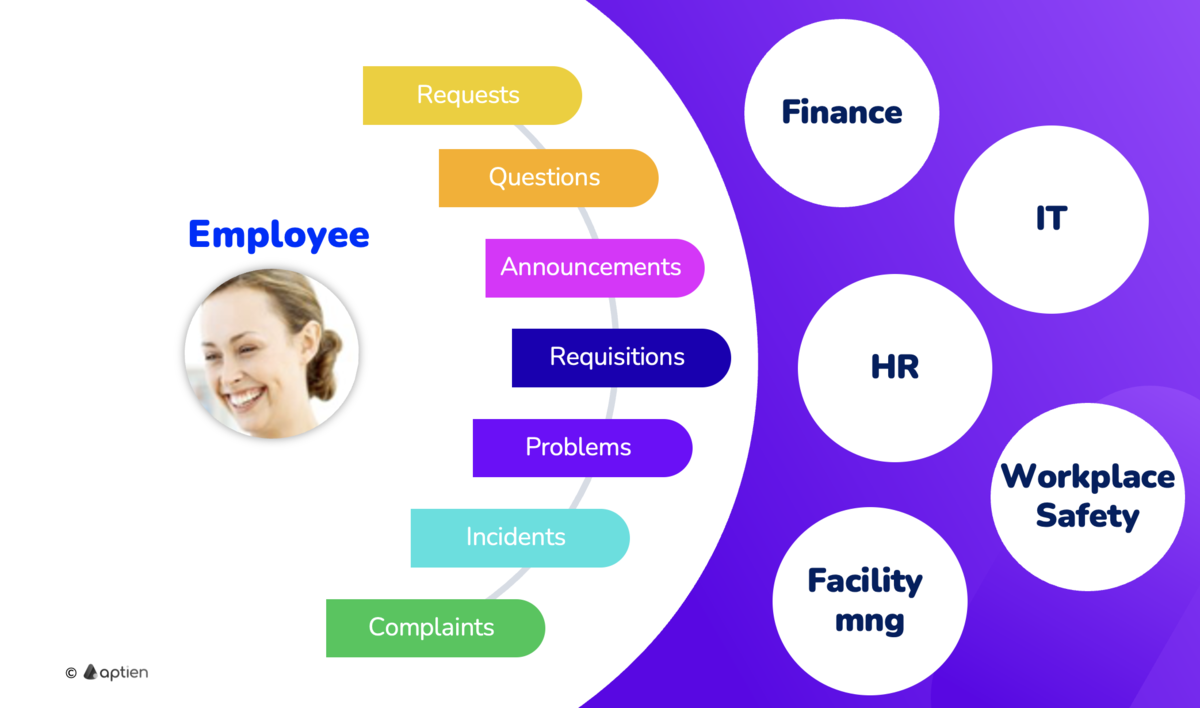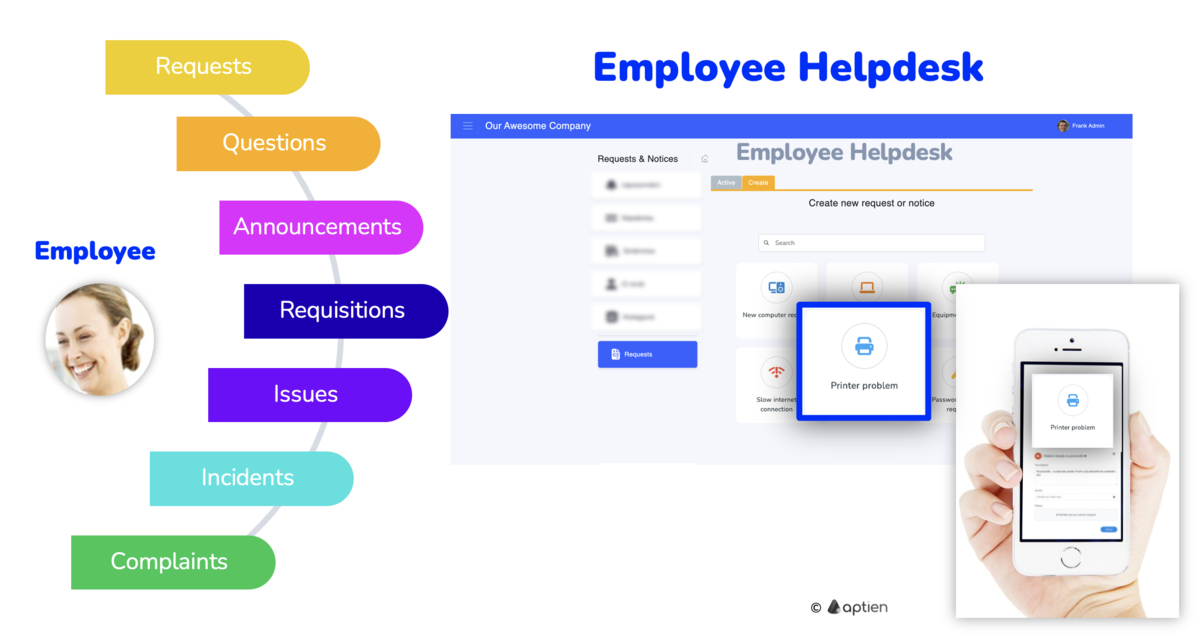Managing Daily Employee Requests and Approvals
Employees submit various requests and approvals every day, such as IT support, equipment needs, expense approvals, and time-off requests. Handling these efficiently becomes challenging as they come from multiple channels—emails, financial systems, workflow tools, meetings, instant messages, or even casual conversations. Without a structured system, requests can be lost, delayed, or miscommunicated.
As a company grows, so do the number of requests. What works for a 10-person team becomes unmanageable for 20 or more employees. At some point, relying on scattered communication is no longer sustainable, and a centralized request management system becomes essential. With a structured approach, HR, IT, and finance teams can efficiently track, process, and approve requests, ensuring nothing gets overlooked.
Managing Employee Requests: Formal and Informal
Employee requests can be formal (e.g., work-related injury reports) or informal (e.g., casual questions or requests). It's up to each organization to choose a method that’s convenient for employees and doesn't overwhelm managers. At the same time, the system should ensure that no requests are overlooked.
In many cases, employers need to track all requests submitted by employees throughout their time with the company, ensuring everything is recorded and monitored.
Employee requests encompasses a broad range of inquiries:
Service Requests
- These are typically non-urgent, routine requests made by employees.
- They can include things like ordering office supplies, requesting IT assistance, or booking meeting rooms. Service requests are often submitted to specific departments such as HR, IT, or facilities.
Equipment Requests
- When employees need new work equipment (e.g., laptops, phones, ergonomic chairs), they submit equipment requests.
- Facilities or IT departments usually handle these.
Incident Reports
- When employees encounter issues or problems, they can submit incident reports.
- These might relate to technical glitches, equipment malfunctions, or security breaches. Incident reports help track and address unexpected events promptly.
Leave Requests
- Employees submit leave requests when they need time off for vacation, illness, or personal reasons.
- HR typically handles these requests, ensuring compliance with company policies.
Expense Reimbursement Requests
- Employees seek reimbursement for business-related expenses, such as travel costs, meals, or supplies.
- Finance or accounting departments manage these requests.
Training Requests
- Employees who want to attend workshops, seminars, or training sessions submit training requests.
- HR or the learning and development team handles these.
Authorization and Access Requests
- Employees seeking approval for access, permissions or specific actions (e.g., keys, entrance cards, account access, accessing confidential data) submit authorization requests.
- These go through relevant channels (e.g., managers, IT, or legal).
Change Requests
- Employees may request changes to existing processes, systems, or policies. For example, if an employee needs access to a new software tool, they would submit a change request.
- These requests often go through IT or relevant departments.
Policy Clarifications
- Sometimes employees need clarification on company policies or procedures.
- These inquiries can be considered as requests for policy information.
Performance Feedback Requests
- Employees may request feedback on their performance, either informally or as part of performance reviews.
- These requests are often directed to managers or HR.
The most frequent requests and requirements of employees
The requirements are directed at superiors or at other back office departments in the company that takes care of the work environment, equipment, and the like. It is most often the HR department, the IT department, the office management, or facility manager who is responsible for the work environment. Very often, these are various reports related to workplace safety and various work incidents. The most common requests include:
- Employee request for reimbursement of expenses (to Finance
department)
- Request for vacation or other leave (to HR)
- Training Request (to HR)
- Purchase request
- Service request
- Request for work equipment (Office management)
- Password change (IT department)
- Reinstalling or installing software (IT department)
- Change of authorizations and accesses to app, systems (for IT)
- Access to personnel folder (to HR)
- Requesting documents for authorization (HR department)
- Report of an occupational accident (to OHS department)
- Reporting a security incident
- Reporting property damage
- Near miss reporting
Solving Employee Request Submissions
In practice, employees submit requests in various ways, but many small and medium-sized businesses don’t have a dedicated system. Requests are often made via:
- Emails
- Oral communication
- Written notes or forms
- Helpdesk systems
- Forms on the intranet
Employee Helpdesk: A Single Point of Contact
With Aptien’s Employee Helpdesk, you can streamline the request process through an employee portal. Employees have a centralized requests and notices page where they can easily submit and report:
- Vacation requests
- Training requests
- Requests for new equipment
Each request is automatically processed through an approval workflow, ensuring that all submissions are handled promptly and efficiently.
Key Features of Aptien’s Employee Helpdesk:
- Single point of contact – Employees submit all requests through one platform, avoiding scattered communication.
- Customizable workflows – Each request type has its own approval process, and these workflows are easy to set up and customize to fit your business needs.
- Simple and sustainable setup – Aptien’s workflow is designed to be easy to use, reducing administrative overhead while ensuring requests are handled properly.
With Aptien, you can customize your workflows to suit the unique needs of your business and ensure that requests and incident reports are managed smoothly and efficiently.
Managing Employee Requests with Aptien’s Employee Helpdesk
At Aptien, we offer an Employee Helpdesk designed to streamline communication between employees and employers. This system helps manage a wide range of employee requests, including:
- Requests (time off, equipment, etc.)
- Questions (about policies, procedures, etc.)
- Reporting Incidents (sickness, accidents, etc. )
- Requisitions (for supplies, approvals)
- Problems, Issues, and Incidents (IT, facilities, etc.)
- Complaints (employee feedback, concerns)
The Employee Helpdesk acts as a centralized platform for managing all these interactions, making it easier for HR, IT, and management teams to respond promptly and efficiently. For more information on using the Employee Helpdesk,

